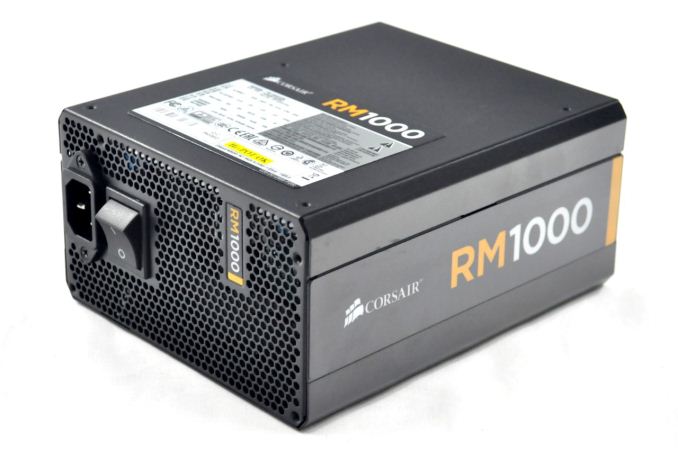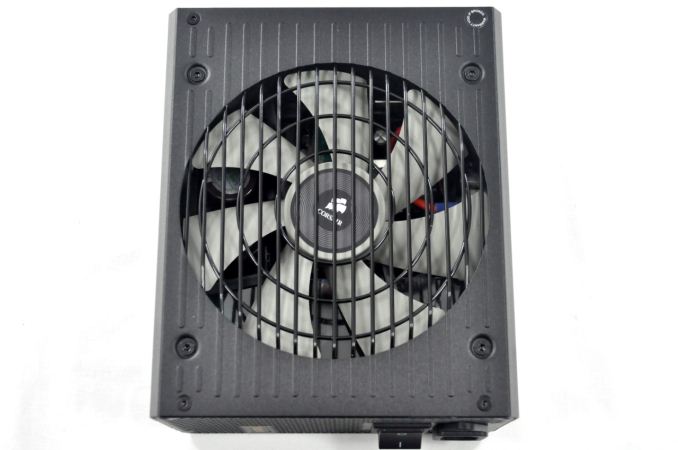Corsair RM1000 Power Supply Review
by E. Fylladitakis on April 24, 2014 6:00 AM EST- Posted in
- Cases/Cooling/PSUs
- Corsair
- PSUs
- RM Series
Conclusion
Most of Corsair's products are focused on specific target groups and the RM PSU series is targeted towards advanced users who appreciate silence above all else. The RM1000 that we reviewed today is the most powerful unit of the series, capable of feeding very high performance gaming systems. It's actually rather strange that the series would expand up to a 1000W unit; it is not impossible to build a system that would require such a massive level of power while remaining quiet, but it would be bulky and very costly. Nevertheless, if you are trying to build a very powerful and low-noise system, the RM1000 is there to lend a hand. Moreover, even though the RM1000 is focused on low-noise operation, it does not mean that Corsair neglected its performance or appearance.
Visually, the subtle modifications, such as the chamfered edges and the rimmed bottom, make the fully modular RM1000 aesthetically pleasing without standing out too much. The all-black, sleeveless cables are another attraction of the unit, as I feel they are visually superior to sleeved color-coded cables; however, because of their ribbon-like design with the wires bonded together, the cables of the RM1000 are a bit stiffer to turn and route than typical cables.
The electrical performance of the RM1000 is very good and we expected nothing less from a CWT platform, which usually are very well designed and made. The RM1000 is highly efficient and remains so even when the ambient temperature increases significantly, which is infrequent even for very advanced designs. It also provides good quality power, with low voltage ripple even under heavy stress.
Where the RM1000 could use some improvement is on thermal performance, as it seems unwise to heavily tune a 1000W unit with such small heatsinks towards low-noise operation. Despite that, the RM1000 kept performing very well during our testing, even with the ambient temperature much higher than its 40 °C rating, but the temperature of the unit increased to uncomfortable levels and the cooling system could not do anything to react because the fan's speed was already maxed out.
When it comes to quality, the Corsair RM1000 scores very well, yet there is room for improvement. The unit is very well made, with an excellent soldering and assembly job. Most primary components come from very reputable manufacturers, such as Nippon Chemi-Con and TAICON. However, some components come from manufacturers with a mediocre reputation, such as the CapXon capacitors on the secondary side of the transformer. Corsair must know what they are doing though, as they are covering the RM1000 with a five-year warranty.
The MSRP of the RM1000 is $199.90 but we found it online for $169.99 after rebate. It's not the cheapest 1000W unit with an 80 Plus Gold certification, but considering the quality and performance of the PSU, the price is justifiable. If you are the kind of user that wants a really powerful PSU tuned for low-noise operation, the RM1000 should find its way into the top few spots of your shortlist.












55 Comments
View All Comments
piroroadkill - Thursday, April 24, 2014 - link
Solid enough, but personally I have no love for Channel Well Technology.Streetwind - Friday, April 25, 2014 - link
Bit of a shortsighted notion... CWT is an OEM, they manufacture in exactly those quality levels that their customers request. If a customer asks for a cheap piece of crap, the OEM will produce them a cheap piece of crap. But if Corsair says that they need a high quality product, CWT builds them a high quality product. PSU production is not rocket science; it's all about how many corners you're willing to cut to drive the price down.dirtyferret - Thursday, April 24, 2014 - link
I've owned two CWT PSU and 5-6 seasonic OEM units. Maybe I was lucky but I never had any issue with the CWT units I have owned with both working well for 5+ years. I did get an antec (seasonic oem) with a bad coil, my other seasonic PSU never had an issue.tech6 - Thursday, April 24, 2014 - link
With CPUs and GPUs becoming more efficient there really is a very small market for 1kW PSUs. Even with dedicated mid-range gaming graphics cards, a lot of new PC never exceed 350W. I wish PSU makers would put as much effort into efficient and quiet low wattage products as they do with overkill products like these.2late2die - Thursday, April 24, 2014 - link
Well to be fair the entire RM line is geared towards quiet and efficient operation, so if you want that with low wattage just get the 450W unit. Of course 1kW units are geared towards the smaller enthusiast market, always have been and probably will always be. With that being said, if you want to build a powerful system (not necessarily cutting edge, but above mid-range) and keep quiet, then you want the 850W or 1kW unit because of the whole "no fan below 40%" thing. Like you said, many systems, even at load might not reach 40%, which just means that your 1kW unit will always work completely silently, so that's one less fan for you to worry about.Daniel Egger - Thursday, April 24, 2014 - link
That doesn't make sense. A high output unit will almost always have a higher loss and thus emit more heat. In other words: it's actually easier to produce a fanless 400W unit than to produce a 1000W unit that runs with a fan at 0 RPM below 400W.PEJUman - Thursday, April 24, 2014 - link
^^not exactly, you're correct for PSUs from 10 years ago, however the 80 certification requirements forces the modern PSU design to be efficient at all loads:the 80 gold requirements: min efficiency @ 20% load = 0.87, 50% load at = 0.9, 100% load = 0.87
Therefore a 450W 80 Gold will only be 3% (6 Watts) more efficient than a 1000W 80 gold at 200W load.
Daniel Egger - Friday, April 25, 2014 - link
My point is this: If you want to build a system designed for 400W max output it does *not* make sense to use a 1000W just because it happens to run at 0RPM below 40% utilisation.BTW: Not sure your what you meant by "you're correct for PSUs from 10 years ago" because your own calculation proves that I'm still correct for current PSUs. 6W are nothing to sneeze especially considering that no decent system has an idle load of 200W, not even an unlocked haswell setup with crossfire r9 295x2 cf. http://www.anandtech.com/show/7930/the-amd-radeon-... (which this PSU couldn't drive anyway) and those figures are going to be much worse for sane setups.
owan - Friday, June 27, 2014 - link
He didn't say at Idle, he said 200W load. Considering that PSU's are most efficient at 50% load, it actually makes some sense to size your PSU to keep the max load closer to 50% than 100%, particularly if you run your system at high loads for a high percentage of its uptime (i.e. long rendering times, long gaming sessions with minimal other usage) With a high end system drawing well over 500W from the wall, a 1000W PSU is a perfectly sane choiceUnknownZA - Thursday, August 20, 2015 - link
The problem is that new GPU's like Maxw ell do draw more power. A normal 980 GTX Ti apparently only draws 250W which is excellent. However, most if not all of the overclocked 980 GTX Ti's that are on the market draw much more power.I have a GALAX 980 GTX Ti HOF and under full load it draws close to 480W.
I currently have a Corsair TX 750W which I thought was more than enough power for my system, currently Z68 with 2600K, but bought a 4790K and Z97 too. However I have had quite a few crashes while playing games and I have come to the conclusion that the PSU is not suppling enough power. So I am looking at this 1000W Corsair RM. I could go with the 850 but the price difference is negligible.